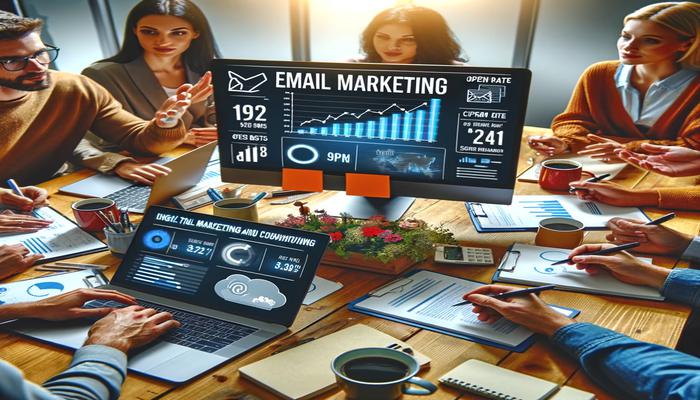Email marketing has become one of the most effective digital marketing channels for businesses looking to acquire new customers and nurture relationships with existing ones. In 2024, email is expected to remain a vital part of any integrated marketing strategy.
This article will explore why email marketing still provides a high return on investment, how to set up a successful email campaign, create engaging content, follow design best practices, leverage automation, analyze results, and optimize based on key metrics. Whether you are just getting started with email or looking to improve your existing efforts, following these tips can help grow your business this year.
Why Email Marketing Still Matters
In an age of flashy social media ads and sophisticated search marketing, email may seem like an old-school way to reach customers. But this channel continues to deliver results even as technology evolves. Here’s why email marketing remains a crucial part of any digital marketing mix:
Email marketing has one of the highest ROI of any marketing channel. According to Campaign Monitor, email marketing yields $42 for every $1 spent, which is a 4,200% return. This far outpaces other forms of digital marketing. No other platform can match email’s ability to drive sales at a low cost.
Open and click-through rates are high compared to other channels. A recent DMA study found that the average email open rate is 21.3%, and click-through rates often fall between 2-3%. These figures beat social media ads and online display ads hands down when it comes to getting audiences to engage.
Email builds relationships with subscribers over time. Pop-up ads and social media posts are easy to ignore, but email allows you to nurture users with valuable, targeted content delivered straight to their inbox. This helps foster trust and loyalty over the long-term.
“Email is the most effective way to maintain relationships in business.” – Email Marketing Expert
Email works for virtually any industry or business model. No matter what you sell or who your target audience is, email marketing tactics can be tailored to meet your unique needs. The versatility of email allows it to complement any existing marketing activities.
It’s a cost-effective addition to a small marketing budget. While platforms like Facebook ads can become expensive quickly, email only incurs small setup costs and monthly fees based on your list size. The ROI is exponential compared to the low investment required.
With such strong evidence proving email delivers real results, ignoring this channel would be a missed opportunity for companies of all sizes and niches. Even if the rest of your marketing is focused on the cutting-edge, a solid email program can provide excellent complementary returns.
Setting Up Your Email Marketing Campaign
Now that the case for email marketing is clear, let’s discuss how to set up your first campaign or optimize your existing efforts. Here are the key steps involved:
Choose an email service provider. The first decision is which software you will use to send, track, and analyze your email campaigns. Leading options like MailChimp, Constant Contact, HubSpot, and ConvertKit each have their own features and pricing. Do your research to find one that aligns with your budget and needs.
Create branded templates. Take the time to design professional-looking templates that reflect your brand identity. This will increase engagement and trust compared to sloppy, amateur designs. Most providers offer templates to customize.
Set up sign-up forms. Make it easy for people to join your list by embedding email sign-up forms on your website, sales materials, and social channels. Offer a compelling freebie like a guide, coupon, or webinar in exchange for their email.
Send confirmation and welcome emails. When someone subscribes, immediately send them an email confirming their sign-up. Follow this with a series of 3-5 welcome emails providing valuable content tailored to new subscribers.
Segment your lists. Group subscribers into segments like customers, prospects, disengaged users, etc. so you can send content relevant to their interests and relationship with your brand.
Develop nurturing workflows. Create automated email series that engage users based on their lifecycle stage and past behaviors. For example, inactive subscribers can receive win-back messages, while active ones get helpful tips.
By laying this groundwork and integrating your email tool with your website, landing pages, and CRM, you will have all the infrastructure needed to execute effective campaigns. Treat email marketing setup as an investment that will pay dividends through higher conversions over the long-run.
Creating Effective Email Content
Now for the fun part – creating compelling content that subscribers eagerly open and engage with. Here are several key tips for writing killer emails:
Offer valuable information like how-to guides, insider tips, and actionable advice. This content helps attract attention among subscribers.
Include images, videos, gifs and other visual content. Emails with visual elements have higher open and click rates. But make sure images are sized properly and videos are easily viewable right in the email.
Personalize content using merge tags. Insert subscribers’ first names, purchase history, interests, or other details into your emails to engage them. Personalized subject lines alone can lift open rates.
Write catchy and benefit-driven subject lines. Given that most people decide whether to open an email based on the subject line, this is an art unto itself. A/B test different options and analyze which ones engage your audience best.
Focus on solving subscriber problems. Understand your audience’s pain points and write content that provides solutions. This type of educational messaging will earn their attention.
“Emails with images have higher open rates than plain text emails.” – Sarah, Email Design Expert
Email copy should be succinct yet compelling. Study what subject lines, offers, and messaging works for leading email marketers in your industry. Test new approaches against tried-and-true favorites to determine the ideal mix based on open and click-through rates.
Email Design Best Practices
Even the most fascinating email content will fall flat if the design is not on point. Use these best practices to make your emails visually appealing:
Templates should be mobile-friendly. Given that most people now access email on smartphones, responsive design is a must so content is easily readable on any size screen.
Calls-to-action should be clear and prominent. Tell subscribers exactly what you want them to do, whether it’s Shop Now, Sign Up, or Learn More. CTAs should stand out with color, size, and placement.
Relevant images and media enhance engagement. As discussed above, incorporate visual elements that contribute to your brand storytelling and messaging. Never use stock photos that appear generic.
Maintain consistent branding. From your logo, fonts and color scheme to tone of voice, ensure all campaigns align with your brand identity. This strengthens familiarity and trust with each exposure.
Layout should be easy to scan. Subscribers should be able to quickly skim the highlights of your email content. Use short paragraphs, plenty of whitespace, bold fonts, bullet points, and other scannable design elements.
Include links to social media. Adding buttons to connect on Facebook or follow on Instagram encourages subscribers to engage across multiple channels and spread the word.
Review emails from other businesses you admire and take note of design aspects that catch your eye. Aim for a mobile-optimized template that makes all elements easy to see at a glance.
Email Automation to Save Time
One of the most valuable aspects of email marketing is the ability to set up automated campaigns that run seamlessly. Here are some automation best practices:
Welcome and onboarding sequences. Immediately build goodwill with new subscribers by sending a series that introduces your brand and key products/services.
Behavioral segmentation and triggers. Send content that corresponds to customer behaviors like opening specific emails, clicking certain links, or making a purchase.
Abandoned cart/browse abandonment flows. Reengage shoppers who left items sitting in their cart or browsed without buying via targeted follow-up messages.
Event-based campaigns. Set up emails around holidays, seasons, annual sales events, or other calendars to capitalize on timely opportunities.
Retargeting and remarketing campaigns. Remind subscribers about popular products, services, or content they previously showed interest in.
Win-back sequences. Attempt to re-activate disengaged subscribers who have not opened in X days with special offers just for them.
The right mix of intelligent automation and triggered messaging will allow you to deliver personalization at scale. Always ensure segmented groups are receiving content relevant to their demonstrated behaviors and lifecycle stage.
Analyzing Results and Optimization
Like any marketing initiative, your email efforts should be constantly measured and optimized. Key metrics to track include:
- Open rate: What % of subscribers open each campaign? Industry averages range from 15-25%.
- Click-through rate (CTR): How many subscribers click links within the email? 2-3% is solid.
- Bounce rate: What % of emails hard bounce due to invalid addresses? This should be lower than 2%.
- Unsubscribe rate: What % of subscribers opt-out from your lists? Lower than 0.2% is ideal.
- Sales attributed to email: How much revenue is directly generated via email campaigns? Look at conversions from clicks.
Based on these key metrics, you can identify opportunities for optimization. For example:
- If open rates are low, test new subject lines, send times, design changes, and email copy.
- If CTR is low, test your calls-to-action, link placement, subject lines and improve email content.
- If hard bounce rates increase, scrub your lists of invalid emails.
- If unsubscribe rates increase, assess why and improve relevancy through better segmentation and targeting.
- If sales are stagnant, re-engage inactive subscribers, promote more products, and improve your post-click landing pages.
A/B testing subject lines, content, design elements, calls-to-action, and other variables allow you to continually refine your approach. Examine email analytics to spot trends and gather insights to guide your optimization efforts. Small tweaks can often lead to noticeable lifts in engagement and conversions over time.
Conclusion and Call-to-Action
Email marketing remains one of the most versatile, cost-effective tactics for reaching customers. By following the tips in this guide, you can develop campaigns that captivate audiences while driving measurable business growth. Treat your email program as a platform for building lasting subscriber relationships.
To learn more about email marketing and how it can benefit your business, contact the experts at Nesace Media. Our strategists can conduct an audit of your current program and provide proven advice on how to boost results. Claim a free 20 minute consultation today to get started.



